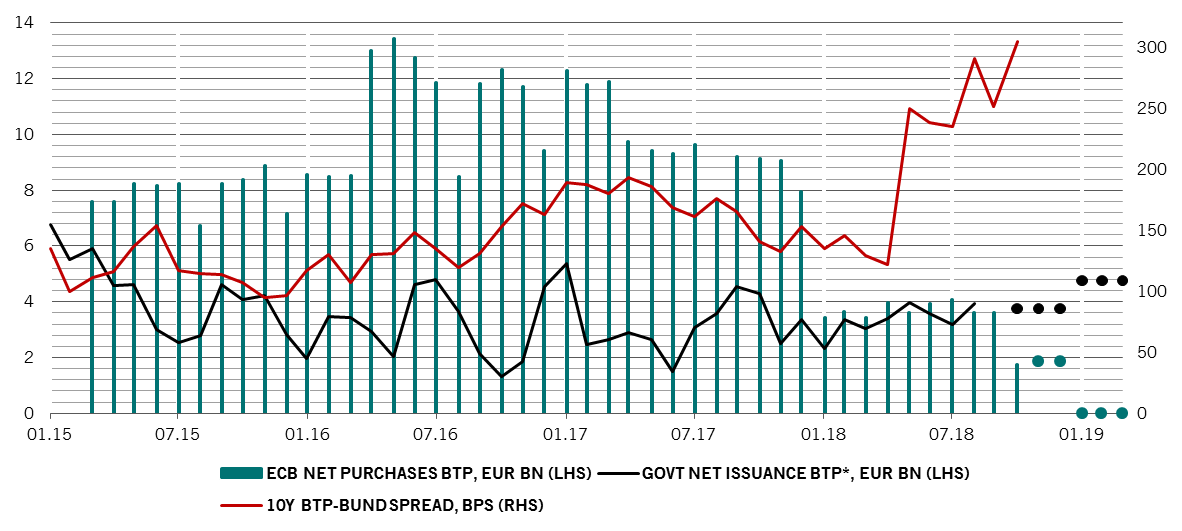Italy's spreading problems
The end of the ECB's quantitative easing programme will put Italian government bonds under more pressure.
Italy’s latest spat with Brussels has been generating headlines. But if crisis strikes, it’s likely to come from a different direction: Frankfurt. That’s because Italy has a debt flow problem. For all the friction the country’s new populist coalition is generating with the European Commission over Italy’s proposed budget, the ultimate source of near-term market tension is the European Central Bank.
That's because Italy has been a major beneficiary of the ECB’s quantitative easing programme. Since the start of QE, the central bank’s purchases of Italian debt have outstripped the volume of new government bonds the country has issued. But as the emergency programme comes to an end, that trend will go into reverse.
Italy’s current budget imbroglio brings forward a problem that would have arisen in the coming months anyway: without ECB buying, Italian yields have to rise in order to draw in private sector funding.
In October, the ECB cut the amount of bonds it was buying under QE to EUR15 billion a month from EUR30 billion – itself a halving of the rate at which it was buying bonds in 2017 – ahead of ending it altogether before the New Year. Then, for the first time in years, price-sensitive private buyers will determine where Italian government bonds trade and, ultimately, whether country's EUR2.3 trillion debt pile - the third largest in the developed world - is sustainable.
Italian government bond spreads vs ECB purchases and Italian government issuance

By the start of November, the ECB held EUR362 billion of Italian government debt, some 17 per cent the ECB’s total holdings of government bonds. As the ECB has bought less debt, Italian yields have been rising. The spread on Italian 10-year bond yields over equivalent German bunds has recently risen above 300 basis points, up from an average of 141 basis points when the ECB had its foot fully on the monetary pedal.
Current projections suggest that on a net basis, and factoring in ECB purchases, the private sector will have to absorb EUR57 billion of Italian government bonds next year. This compares with EUR11 billion in 2018 and a negative EUR54 billion in 2017 (ie there were net sales by the private sector in that year).
The question is what that means for spreads. Even if conditions calm down, spreads are unlikely to return to their averages of the past few years. As a best guess, the new range for Italian debt is somewhere between 250 to 350 basis points – the top of the range representing the level at which bank deposits flooded out of peripheral country banks during the euro zone crisis of 2010-2012. At the same time, our economists estimate that once Italian sovereign yields rise above 4 per cent, the debt becomes unsustainable, other things being equal.
As for now, concerns about Italy’s relations with its European partners mean that financial markets are starting to price in the risk the country drops out of the euro, which will contribute to the wider spread. Currently, our estimates suggest investors are demanding 200 basis points for credit risk and 100 basis points for the possibility Italy will be forced to re-denominate – we estimate that the market is pricing in a 7 per cent probability that Italy will be forced out of the euro over the next couple of years.
Italy is back on the front burner – and with reason.
Important legal information
This marketing material is issued by Pictet Asset Management (Europe) S.A.. It is neither directed to, nor intended for distribution or use by, any person or entity who is a citizen or resident of, or domiciled or located in, any locality, state, country or jurisdiction where such distribution, publication, availability or use would be contrary to law or regulation. The latest version of the fund‘s prospectus, Pre-Contractual Template (PCT) when applicable, Key Information Document (KID), annual and semi-annual reports must be read before investing. They are available free of charge in English on www.assetmanagement.pictet or in paper copy at Pictet Asset Management (Europe) S.A., 6B, rue du Fort Niedergruenewald, L-2226 Luxembourg, or at the office of the fund local agent, distributor or centralizing agent if any.
The KID is also available in the local language of each country where the compartment is registered. The prospectus, the PCT when applicable, and the annual and semi-annual reports may also be available in other languages, please refer to the website for other available languages. Only the latest version of these documents may be relied upon as the basis for investment decisions.
The summary of investor rights (in English and in the different languages of our website) is available here and at www.assetmanagement.pictet under the heading "Resources", at the bottom of the page.
The list of countries where the fund is registered can be obtained at all times from Pictet Asset Management (Europe) S.A., which may decide to terminate the arrangements made for the marketing of the fund or compartments of the fund in any given country.
The information and data presented in this document are not to be considered as an offer or solicitation to buy, sell or subscribe to any securities or financial instruments or services.
Information, opinions and estimates contained in this document reflect a judgment at the original date of publication and are subject to change without notice. The management company has not taken any steps to ensure that the securities referred to in this document are suitable for any particular investor and this document is not to be relied upon in substitution for the exercise of independent judgment. Tax treatment depends on the individual circumstances of each investor and may be subject to change in the future. Before making any investment decision, investors are recommended to ascertain if this investment is suitable for them in light of their financial knowledge and experience, investment goals and financial situation, or to obtain specific advice from an industry professional.
The value and income of any of the securities or financial instruments mentioned in this document may fall as well as rise and, as a consequence, investors may receive back less than originally invested.
The investment guidelines are internal guidelines which are subject to change at any time and without any notice within the limits of the fund's prospectus. The mentioned financial instruments are provided for illustrative purposes only and shall not be considered as a direct offering, investment recommendation or investment advice. Reference to a specific security is not a recommendation to buy or sell that security. Effective allocations are subject to change and may have changed since the date of the marketing material.
Past performance is not a guarantee or a reliable indicator of future performance. Performance data does not include the commissions and fees charged at the time of subscribing for or redeeming shares.
Any index data referenced herein remains the property of the Data Vendor. Data Vendor Disclaimers are available on assetmanagement.pictet in the “Resources” section of the footer. This document is a marketing communication issued by Pictet Asset Management and is not in scope for any MiFID II/MiFIR requirements specifically related to investment research. This material does not contain sufficient information to support an investment decision and it should not be relied upon by you in evaluating the merits of investing in any products or services offered or distributed by Pictet Asset Management.
Pictet AM has not acquired any rights or license to reproduce the trademarks, logos or images set out in this document except that it holds the rights to use any entity of the Pictet group trademarks. For illustrative purposes only.



